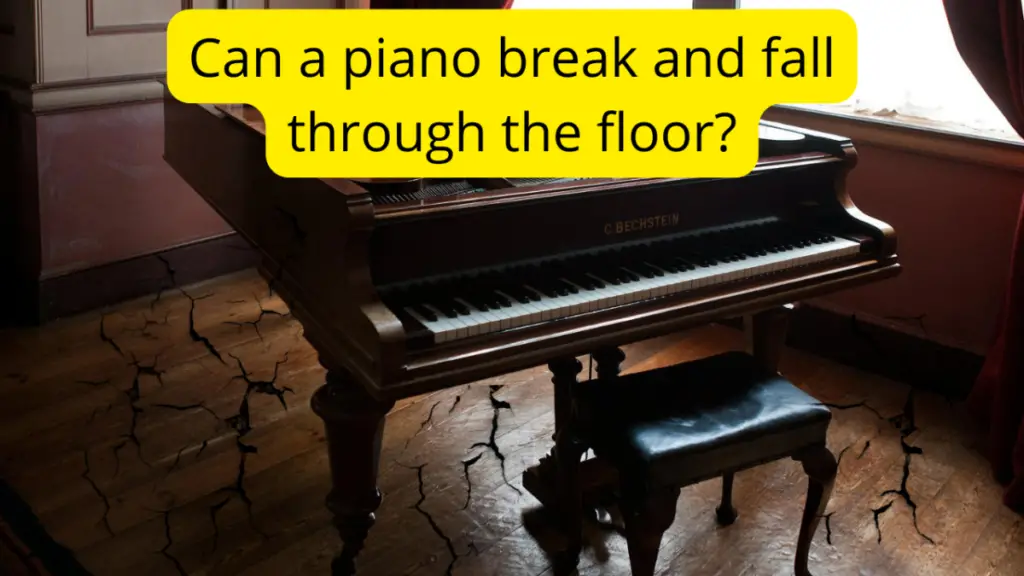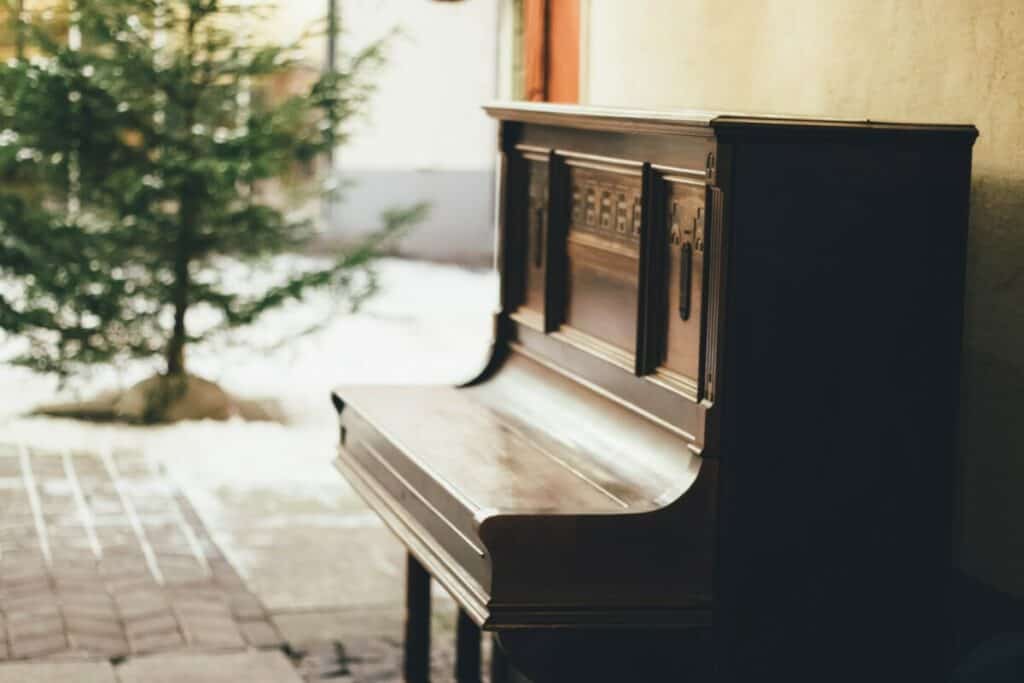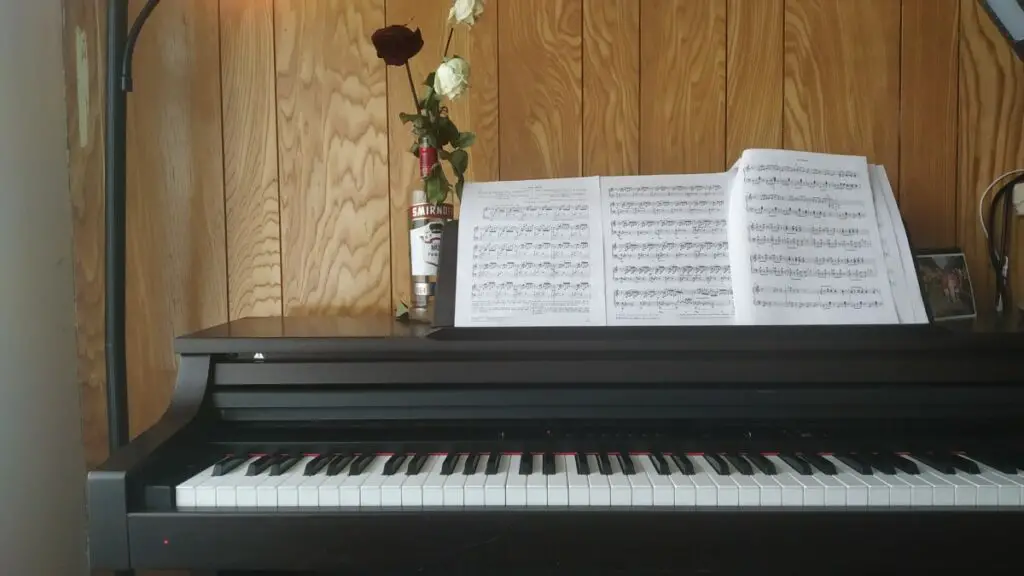This post contains affiliate links.
The piano is known to be the heaviest among the different musical instruments out there. With an average piano weighing at least 500 lbs, making it the heaviest piece of furniture in a house, this raises the question: is it safe to put a piano on a second floor? Is it possible for a piano to collapse and fall through the floor?
Floors in houses built nowadays can support the weight of a piano, thanks to the International Residential Code construction regulations. If your room can hold 5 adult men then it can hold a grand piano. However, if your house is old or there are termites, consult a structural engineer.

Read more to find out what different types of pianos are out there and how much each type of piano weighs, as well as how to quickly calculate if your floor can support a piano.
Finally, I will give some tips on where to place a piano so that it won’t damage the floor.
How heavy is a piano?
What different types of pianos are out there?
Grand pianos: the biggest type of piano constructed using the finest materials to produce the clearest and grandest sounds possible. Grand pianos are known for their black silhouettes, open lids and iconic curvatures and are primarily used in concerts or show up in movies.
The most well-known brand for grand pianos is Steinway, with some of their base model piano costing at least $100,000

Upright pianos: more commonly seen in homes, upright pianos also use strings and hammers like grand pianos to create sounds. However, instead of the strings and hammers being laid out flat horizontally in a grand piano, they are positioned vertically in an upright piano to save space.
This gives the upright piano its distinctive tall silhouette and its compact form factor, making it more portable and taking less space compared to a grand piano.

Digital pianos: don’t use strings and hammers to create sounds like acoustic pianos, instead it plays pre-recorded digital sounds when you press down on the keys. This is why digital pianos are shorter in height and are lighter compared to upright pianos.
With that said, digital pianos are designed to emulate the touch and feel of acoustic pianos, giving you the playing experience and sounds just like the real thing. Also, note that there are grand and upright versions for digital pianos to choose from.
I personally own a digital piano so I don’t need to spend money to tune an upright piano once every year.

How much does each type of piano weighs?
| Digital pianos | Upright pianos | Grand pianos |
| 100 lbs – 300 lbs (45 kg – 136 kg) | 300 lbs – 500 lbs (136 kg – 226 kg) | 700 lbs – 1000 lbs (317 kg – 453 kg) |
For digital pianos, there’s even a portable Yamaha digital piano that can be assembled and disassembled, weighing about 47 lbs (21 kg).
Most upright pianos are closer to even more than 500 lbs
There are grand pianos that are as heavy as 1200 lbs.
To find out the weight of a particular piano you’re having your eyes on, check its specifications on the brand’s website.
How to calculate if your floor can support a piano
As per the International Residential Code, second-floor bedrooms are required to hold 30 pounds per square foot (psf) and all other rooms have to hold 40 pounds per square foot.
Floors in office buildings or department stores will have to have a higher load per square foot as they have to support the weights of many people and heavy objects.
To calculate how much weight can the room support, find the area of the room by multiplying the room’s width and length. Then multiply that area by the load per square foot (psf)
Total support weight = room’s width * room’s length * load per square foot
For example, a 10 ft x 15 ft bedroom will have an area of 150 square feet, thus that bedroom will have a load capacity of 4500 lbs. This means you could theoretically fit in 4 grand pianos in this room, each weighing at least 1000 lbs!
A good rule of thumb to remember is that if your room can hold 5 adult men, each weighing around 200 lbs, then the room can hold a grand piano.
What this means is that even the floor in the bedroom can support a grand piano, though you should place a grand piano in a more spacious area like the living room to be on the safe side.
Finally, if you’re still unsure or if your house is ancient and there might be termites problems, hire a structural engineer to inspect your floor and make sure it’s safe to place a heavy piano on the floor, especially if it’s a grand piano on the second floor.
Where to place a piano to not break the floor
Place a piano closer to the wall since it’s more structurally sound there and can support heavy objects better. Don’t place a piano in the middle of the room as it’s the weakest point in the room and can’t support heavy objects.
Distribute all the pieces of furniture evenly throughout the room and don’t put the piano in the same spot as other heavy objects as this can damage the floor.
Also, make sure to place your piano in a spot where sunlight can’t reach it and the humidity is constant. This is because sunlight and extreme humidity (either too dry or too damp), can damage the piano, making you call for a piano tuner sooner than expected.
To read more on why sunlight and extreme humidity is bad for your piano, as well as the ideal humidity for an acoustic piano, check out Places to NOT Put Your Piano At
Finally, if you have hardwood floors or floors that can be scratched easily, get some caster cups on Amazon (affiliate link) to put them under the piano legs or put a rug under your piano. Putting a rug under the piano also helps block sounds and vibrations if you have tenants or neighbours living below your floor.
If you’re living in an apartment and don’t want to bother your neighbours below and on the sides with your piano playing, check out 8 Tips to Practice Piano Without Disturbing Your Neighbours

